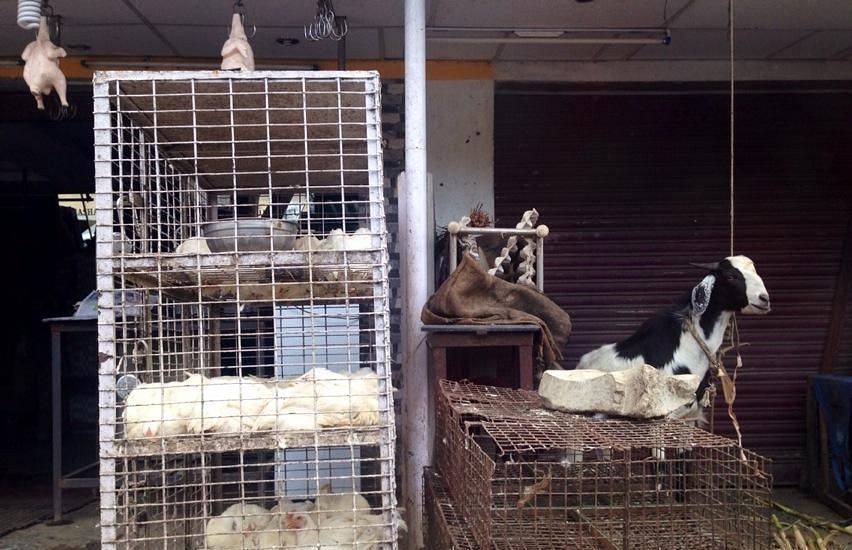News Brief
Explained: Bird Flu Caused by H5N1 Virus Has Alarmed Poultry Farmers In Many States Including Punjab, Maharashtra
- Human to human transmission is rare but when people do become infected with H5N1 virus, the mortality rate is about 60 per cent
- WHO suggests that it is safe to eat properly prepared and cooked poultry

India’s poultry industry is largely informal with small slaughtering units run by individual butchers. This increases the risk of infections. (Source: Twitter)
A dead bar-headed goose tested positive for the flu's H5N1 strain in Punjab, the forest and wildlife preservation department officials said today (20 January).
Last Saturday, the union government said bird flu in poultry has been confirmed in nine districts of Maharashtra, while culling operation in poultry is underway in one district each in Madhya Pradesh and Chhattisgarh.
The goose in Punjab was found dead near the Siswan Dam reservoir in Mohali and its samples were sent to the Northern Regional Disease Diagnostic Laboratory (NRDDL) in Jalandhar for testing on 8 January, reports Livemint.
The officials said that a team of the animal husbandry department had also visited the reservoir area.
Apart from poultry, the viral disease has been confirmed in crow in Uttarakhand, Gujarat and Uttar Pradesh, while in pigeon, brown fish owl and Heron in Delhi.
H5N1 is a type of influenza virus that causes avian influenza or “bird flu”, a highly infectious, severe respiratory disease in the birds.
According to WHO, human cases of H5N1 avian influenza occur occasionally, but it is difficult to transmit the infection from person to person. It says that almost all cases of H5N1 infection in people have been associated with close contact with infected live or dead birds, or H5N1-contaminated environments. The virus does not infect humans easily, and spread from person to person appears to be unusual.
However, the challenge is the high mortality. When people do become infected with H5N1 virus, the mortality rate is about 60 per cent. Also, the virus can mutate and become more easily transmittable among humans.
Minister for Fisheries, Animal Husbandry and Dairying Giriraj Singh said on 12 January that he had met Punjab Poultry Federation representative in Krishi Bhawan, and discussed about issues related to bird Flu and assured them for all the possible support.
Reportedly, Bird flu or avian influenza is spread mainly by migratory birds coming into India during winter months from between September and March.
The states, fearing the spread of the disease, have decided to impose a ban on sale of poultry and poultry products. This would adversely affect not only the poultry farmers but also the maize farmers, maize being the dominant feed crop.
"It is reiterated that consumption of well cooked chicken and eggs is safe for humans. Consumers should not heed to baseless rumours that are unscientific and often lead to confusion," it said.
The centre noted the impact on the poultry and egg markets and the farmers, who are already affected by the Covid-19 pandemic lockdown, and advised the state governments to rethink their decisions to impose a ban on sale of poultry and poultry products and allow selling of poultry and poultry products sourced from the non-infected areas or states.
WHO suggests that it is safe to eat properly prepared and cooked poultry and game birds. The virus is sensitive to heat. Normal temperatures used for cooking (so that food reaches 70°C in all parts) will kill the virus.
Most of the human infections, according to WHO, are caused by home slaughter and subsequent handling of diseased or dead birds prior to cooking.
India’s poultry industry is largely informal with small slaughtering units run by individual butchers. This increases the risk of infections.
The WHO website lists the symptoms of H5N1 infection as: fever (often high fever, more than 38°C) and malaise, cough, sore throat, and muscle aches.
Other early symptoms may include abdominal pain, chest pain and diarrhoea. The infection may progress quickly to severe respiratory illness (for example, difficulty breathing or shortness of breath, pneumonia, Acute Respiratory Distress Syndrome) and neurologic changes (altered mental status or seizures).
Introducing ElectionsHQ + 50 Ground Reports Project
The 2024 elections might seem easy to guess, but there are some important questions that shouldn't be missed.
Do freebies still sway voters? Do people prioritise infrastructure when voting? How will Punjab vote?
The answers to these questions provide great insights into where we, as a country, are headed in the years to come.
Swarajya is starting a project with an aim to do 50 solid ground stories and a smart commentary service on WhatsApp, a one-of-a-kind. We'd love your support during this election season.
Click below to contribute.
Latest